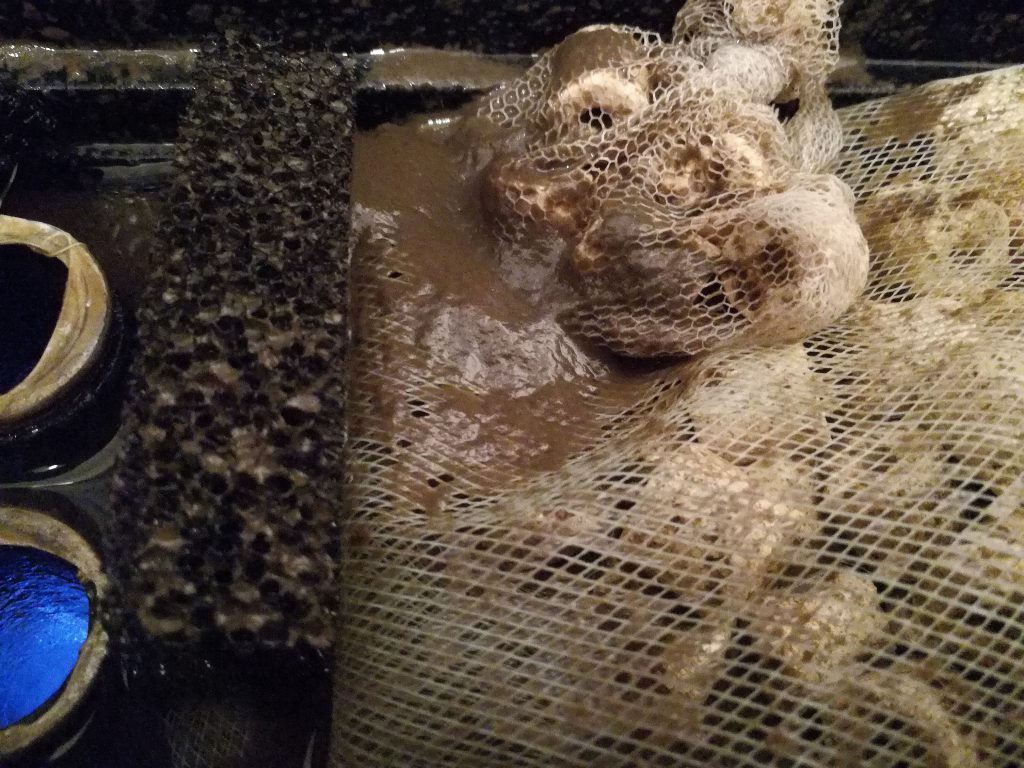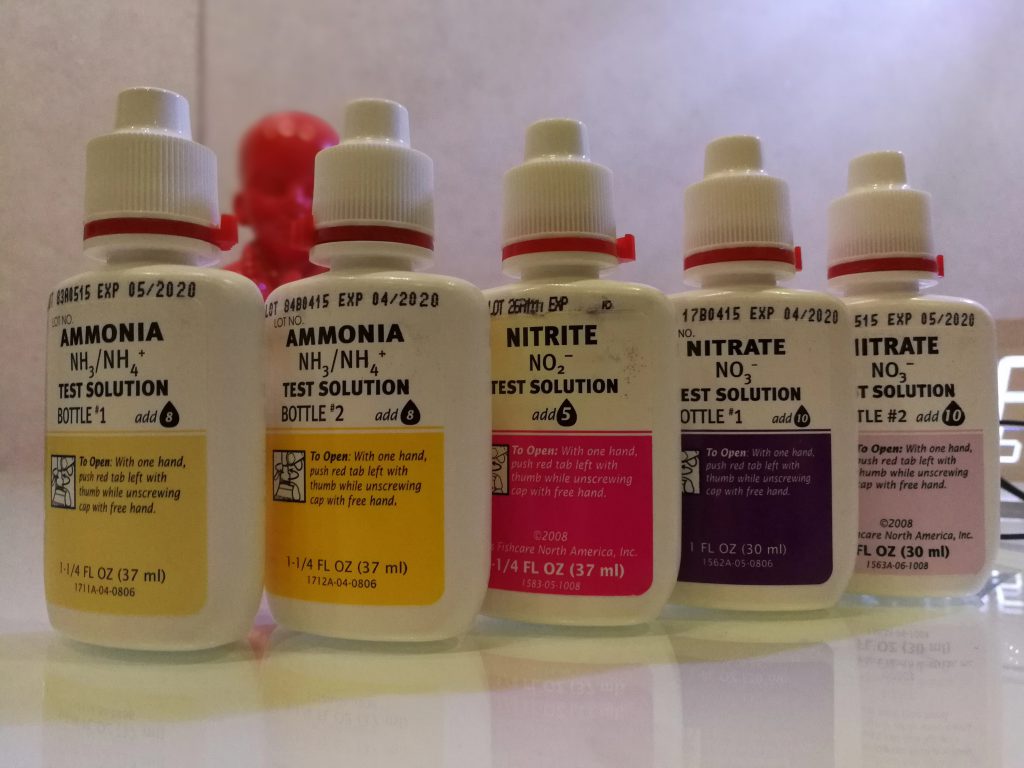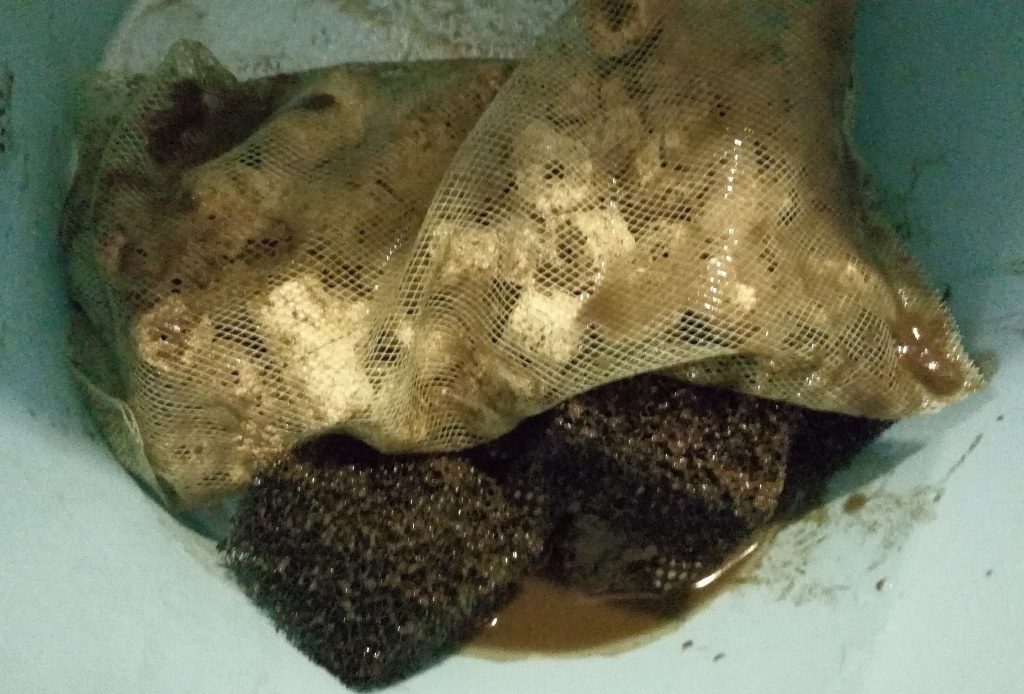After we have set up our new fish tank, I am sure the first thing we wanted so much to do is to start putting the goldfish in. If we do that, we will be putting that goldfish into a stressful environment with the risk of dying… unless it is for sacrificial purpose.

This is because the new tank is undergoing the Nitrogen Cycle process which releases toxic compounds into the water. As it is a new setup, there aren’t enough nitrifying bacteria (the good guys) to break those damn toxic compounds down to non toxic.
This is why we need to cycle the fish tank. We need to let these bacteria establish their colonies first in order for the fish tank to be safe for our fish. They grow mainly in the filter media and substrate. There are less amount of them on the decorations and in the water.
Curious on how these bacteria look like to our naked eyes?

This is a picture of some filter media in one of my established fish tank’s filter. The brown stuff are the good bacteria. Yummy looking right? 🙂
Before you start to cycle the fish tank…
Make sure you have test kits that are able to check for Ammonia, Nitrite and Nitrate. The test results will let you know how the cycle is going.
Note: The following paragraphs contain affiliate links. For more information, please visit my disclosure page.
I am using API Freshwater Master Test Kit. I like this master test kit because besides having test kits for Ammonia, Nitrite and Nitrate, there are also test kits for pH and high range pH. These kits are in liquid form.
To do the tests, take some water out from the fish tank and put it into the clean glass test tubes that are already provided in the master kit. Each test tube is used for one test. Give your test kits a nice shaking, then follow the instructions on how many drops of the test kit that you need to add into the test tube for each test. Cover (also provided) the test tube and shake it nicely. Leave it for around 5 minutes and then compare the result with a color chart that comes with the master kit.
OK, so how to cycle the fish tank?
Firstly, please turn on your filter and let it run.
The important step in cycling is to have Ammonia in the tank as it is food for the good bacteria to grow. This can be achieved through 2 methods:
- Cycling with fish
In another words, this is the method where you sacrifice a fish. You will need to use a healthy fish as you do not want to introduce any disease into the tank. So you put that sacrificial fish into the tank, and the wastes from this fish will turn into Ammonia that will kick off the cycle. However this poor fella will be subjected to the toxic compounds until the cycle is completed (i.e. if it’s tough enough to go through all those). You will need to do frequent water changes (25%-50%) when you see the fish’s condition deteriorate.

- Cycling without fish
This method is simulating the situation where Ammonia is introduced into the water. No live fish sacrifice is required. This can be done by putting excess fish food or dead shrimps into the tank. When they decompose, Ammonia will be released into the water. Another way is to add pure Ammonia directly into the tank. Do make sure it is pure Ammonia with no additives. Additives may leak poison into the tank. Use this calculator to determine how much pure Ammonia you need for your tank size to achieve the ideal of 3ppm concentration.
Another way is to add pure Ammonia directly into the tank. Do make sure it is pure Ammonia with no additives. Additives may leak poison into the tank. Use this calculator to determine how much pure Ammonia you need for your tank size to achieve the ideal of 3ppm concentration.
After doing whatever necessary to have Ammonia in your tank, the next thing to do is wait. The cycling process typically takes around 1-2 months to complete.
How to know whether the cycle is working?
During this period of time, do regular water tests for Ammonia, Nitrite & Nitrate to determine which stage your cycling is at. Do these at least once a week.
 As the cycle progresses, you will see the following changes to your test results:
As the cycle progresses, you will see the following changes to your test results:
- Stage 1: Ammonia increases –> due to the Ammonia introduced via fish wastes, decomposing fish food/shrimp or the pure Ammonia that you’ve added.
- Stage 2: Ammonia slowly decreases, Nitrite slowly increases –> Nitrosomonas bacteria are already breaking down Ammonia
- Stage 3: Ammonia decreases, Nitrite decreases, Nitrate increases –> Nitrosomonas & Nitrobacter bacteria are already working together to break down the toxic compounds
- Stage 4: No Ammonia, No Nitrite, Nitrate increases –> Your bacteria colonies are already established. Cycle completed.
After the cycle is complete, do a big 50% water change to remove Nitrate and your tank is now safe for your goldfish.
Is there a way to speed up the cycling?
Yes, if you are able to get hold of some existing bacteria colonies. You can add them to your filter or into your fish tank and it will speed up the bacteria growth. You can get them from:
- Filter media or substrate from healthy established tanks.
Do not clean these filter media or substrate. Take them as they are (i.e. along with those brown yucky stuff)
Filter Media from established tank - Bottled bacteria products in the market.
I have tried one of the brands before but it didn’t work for me. Anyhow if you are getting this, make sure to check the expiry date!
I have used some filter media from my other established tank to cycle my goldfish tank. It took around 2 weeks to complete cycling.
Yay!… can I add my goldfish to the tank already?
Yes, you can… but don’t go crazy and add a big bunch into the tank in one shot. Be patient and add one or two at a time. Give it around a week’s interval for the good bacteria to adjust to the bio load of the fish tank.

So once your fish tank is cycled, the colonies of bacteria will continue to grow and keep your fish tank safe for your goldfish; unless majority of them are removed or destroyed. This can happen by washing your established filter media or substrate with chlorinated tap water. If this is the case, you will need to cycle the fish tank again.
So these bacteria are very important in fish keeping. Take care of them and they will take care of your goldfish!

Wow I never realized so much goes into building a fish tank before putting the goldfish in! This cycling is quite the task. I feel kinda bad for the sacrificial fish 🙁 I’m glad there are other ways to cycle instead of basically having to just let one little guy go. Great post. Very interesting!!
Hi Bailey,
Thanks for dropping by.
Cycling the tank is indeed quite a task, but it is a very essential one. The good news is, you just need to do it once for a tank as long as you maintain the good bacteria there. 🙂
An interesting read on cycling a fish tank properly. Perhaps this is whey I have not had great luck with fish tanks.
Thank You for the education and I will be reading your other posts to learn more on keeping my future fish alive
Hi Clyde,
Thanks for your comment. Glad that it gives you an idea on what you’ll need to do in the case you decide to pick up fish keeping again. 🙂
hi Alex, thanks for this article. I find it amazing. I am aware that some fish species need normal water and some need fresh sea water to survive in aquariums. However, I find this article very interesting because there is more to know than the simple kind of water needed. I am actually planning to soon get an aquarium and this information greatly helps. These are some of the info that pet shops rarely tells you. It takes one expert hobbyist or fish expert like you to provide us with very valuable information like this. Thank you very much =)
Hi JR,
Thanks for the comment. I am happy to hear that this information will be a great help for you when you start up your fish tank. All the best to you!
Thanks Alex for informative post. When I started my fish tank 3 years ago, I remember not putting any fish and I just let it recycled. What happened few days later snails have started to grow in it. I certainly didn’t put them in, suppose snails eggs must have with the water. Do you think it could have started the bacterial cycle? because when I put my first batch of fish, none of them died.
Hi Fred,
Thanks for the comment. The snail eggs may have come from the decorations, plants or substrate that you have put in, that is if you did put them in. I would be very surprised if they came from your tap water. Anyway the snails or any decomposing material in your tank could have kick started the cycle.
You really know your stuff about fish tanks! I was always curious about the ammonia level in my new tank and this cleared all of that up for me. Thanks a lot!
Thanks Dan. Happy to help!
Wow this explains why I lost so much fish all the time. I never realised so much went into it. I knew of a 50% change in water but that was it. Thanks for this great advice I will bookmark your site ready for when we get our large tank that we are planning in our new house. Thanks again
Hi Graham,
Glad to be of help. All the best with your new house and the new large tank!
So if you get a used filter from a good tank to introduce good bacteria at the beginning, how do you know when it is safe to introduce fish? Right away as long as you don’t do too many?
If you use this method then would you test and for what?
Thanks!
Hi Jessica,
It is always recommended to do water testing when you are starting a tank, even when you are using a used filter.
A good test kit that I will recommend is this:
API Freshwater Master Test Kit
Anyway assuming the filter (or filter media) is from an established tank from the same size, yes, you can introduce your fish in, but not too many at the same time. Make sure you always do water testing to gauge the water quality. If you see any ammonia or nitrite in the readings, you will need to do more regular water changes. We still need to do water test because we really do not know whether the bacteria from the old filter is still healthy or enough to handle the load in the new tank. So it’s always good to check.
Even with established tanks, we should still do water testing because that is the only way to gauge water quality. There could be many factors that impact the beneficial bacteria colonies in the water. For example: During your regular maintenance, you accidentally wiped off some of these colonies. Another example is that you added some new fish which increased the amount of wastes in the water, and the current bacteria colonies are not big enough to handle the load.
Thanks Alex. It is such a strange art trying to figure it all out and make it work! My husband always wanted an aquarium and didn’t realize how much work it was! He is a good sport but it was interesting to see him realize just how much is required!
Jessica
Hi Jessica,
Yeah… and that makes it interesting as well. 🙂 All the best to you and your husband in your fishkeeping journey! 🙂
Hi Alex,
My son received a fish tank kit (Tetra, 60 liter) for Christmas, here in Switzerland.. we set it up with tap water, waited approximately six weeks and then received a thumbs up on water test and were able to add fish..
Our fish now have clamped fin and we have lost 2 little guys.
Prior to loosing any, we were instructed to do 50% water change, adding Easystart Bacterial Combi System every 4 weeks, and filter change every 4 weeks, alternating every 2 weeks with either water or filter.
Now, I was told to add salt, 1 tsp. Dissolved in a liter of warm water, twice a week and also to treat for Ich, with a product called Ichtex. I have done 2 treatments so far, one Thursday and one Saturday with a 50% water change both days. I am due to do another one today but I am not sure if I am actually helping them! I don’t see any white spots. Some have clamped fin, with white stingy poop, lethargic and poor color.
Just not sure if I should stop everything, do constant water changes, change out filter as it was due last Tuesday for a change. (Been in for 4.5 weeks).. or let everything just be? I have tested water with just rest strips and everything is good..
Sorry for such a lengthy post..
Hi Colleen,
I am so sorry to hear about the situation with your fish. Your fish tank is 60 litres, so it is around 15 US gallons.
What kind of fish do you have in there? If these are goldfish, then the space is really too small for them.
Anyway based on what you have written and with the assumption that the tank is cycled (i.e. no ammonia, no nitrite and no/little nitrate), these are what I think:
1) As there is no sign of ich, stop with the ich medication. Medication (when not necessary) stresses out the fish even more.
2) For salt treatment, I am assuming you are using aquarium salt. If you are using table/cooking salt, stop!! Those contain additives that are harmful to your fish. Please check out this post on using aquarium salt. After you added salt, you don’t keep on adding them unless you do water change. Also, when dissolving them, use water of similar temperature with your fish tank’s water.
3) What filter are you using? In my opinion, you do not need to keep changing or cleaning your filter unless they are dirty. Even when you clean it, do not use tap water as this will kill off those beneficial bacteria.
Check out this post on more information on why this may be happening and how you can deal with them. I do hope things will get better. Do let me know how the situation turns out.